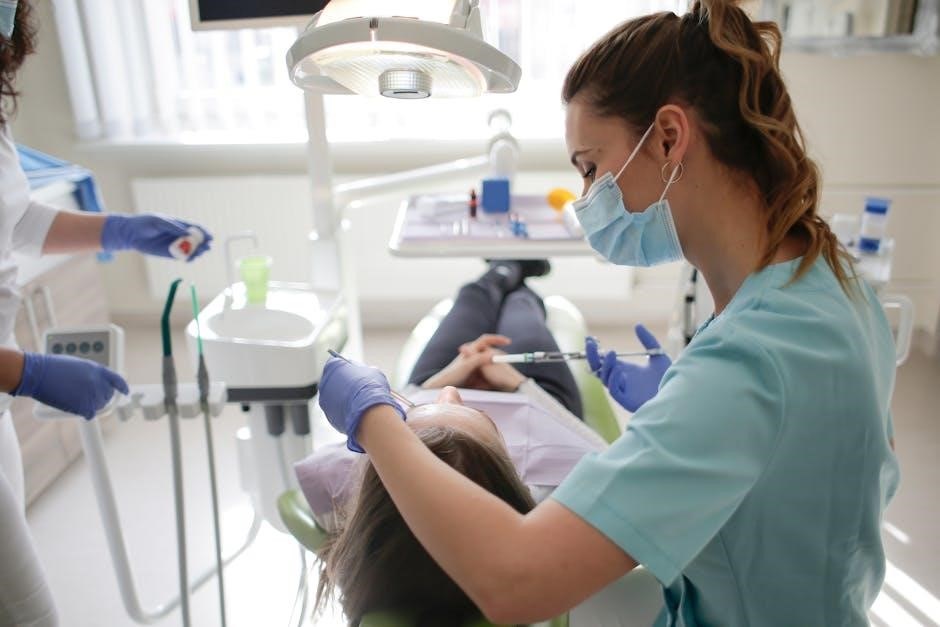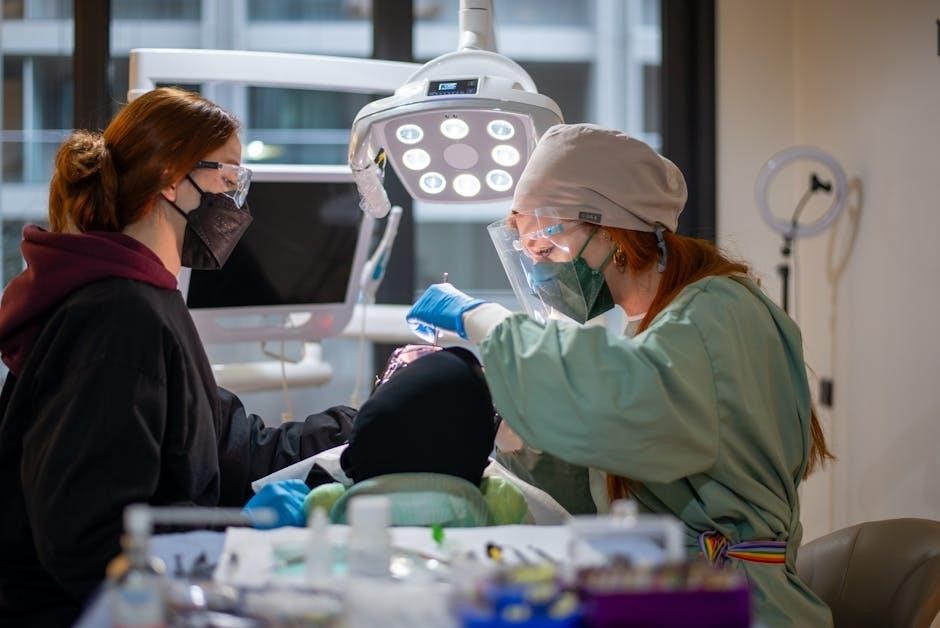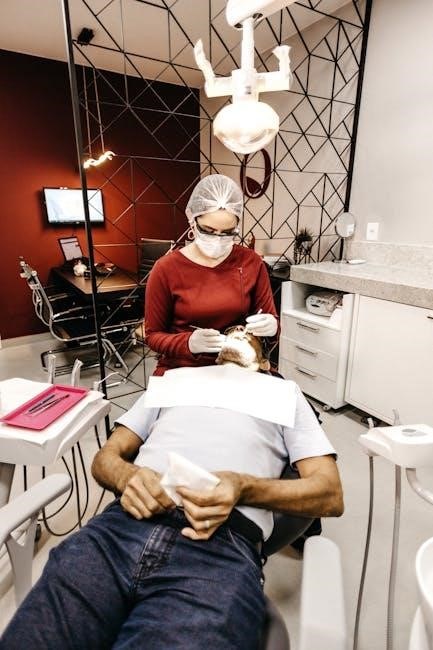
dental assistant exam questions and answers pdf
Passing the dental assistant exam requires thorough preparation. This guide provides essential insights‚ including exam structure‚ key topics‚ and study resources like PDF guides and practice exams to ensure success.

Exam Overview
The dental assistant exam is a comprehensive assessment designed to evaluate knowledge and skills in dental assisting. It is divided into three main sections: General Chairside Assistance‚ Infection Control‚ and Dental Radiography‚ with a total of 255 multiple-choice questions. Candidates have three hours to complete the exam‚ and all questions must be answered. The exam focuses on practical aspects of dental assisting‚ including patient care‚ procedures‚ and safety protocols. Resources like PDF study guides and practice exams are widely available to help candidates prepare effectively. Understanding the exam format and content is crucial for success‚ as it ensures familiarity with the types of questions and time management strategies. Proper preparation and review of key topics‚ such as dental terminology and radiography procedures‚ are essential to achieve a high score. The exam is graded based on the difficulty of correctly answered questions‚ emphasizing the importance of thorough study and practice.

Exam Structure
The exam consists of three sections: General Chairside Assistance‚ Infection Control‚ and Dental Radiography‚ totaling 255 multiple-choice questions. It assesses practical knowledge and skills in dental assisting procedures and safety protocols effectively.
3.1. General Chairside Assistance
General Chairside Assistance is a critical component of the dental assistant exam‚ focusing on practical skills and knowledge. This section evaluates the ability to assist during procedures‚ maintain patient comfort‚ and manage instruments effectively. Key topics include preparing patients for treatment‚ handling dental instruments‚ and ensuring asepsis. The exam also covers suctioning techniques‚ retracting tissues‚ and proper use of dental materials. Understanding how to pass instruments correctly and maintain a clean‚ efficient workspace is essential. Additionally‚ this section assesses knowledge of common dental tools and their applications. The questions are designed to reflect real-world scenarios‚ ensuring candidates are prepared for clinical settings. Mastery of these skills is vital for success as a dental assistant‚ emphasizing the importance of hands-on training and practice in this area.
3.2. Infection Control
Infection Control is a fundamental section of the dental assistant exam‚ focusing on preventing the spread of diseases in clinical settings. This section tests knowledge of sterilization methods‚ disinfection protocols‚ and proper use of personal protective equipment (PPE). Key topics include handling contaminated instruments‚ waste disposal‚ and maintaining asepsis during procedures. The exam also covers understanding of infection control regulations and guidelines set by health organizations. Questions may involve scenarios requiring identification of proper infection control measures‚ such as correct handwashing techniques or appropriate sterilization methods for specific instruments; Mastery of infection control principles is crucial for patient and staff safety‚ making this section a critical area of focus for exam preparation. Ensuring compliance with these protocols demonstrates a commitment to professional standards and patient well-being.
3.3. Dental Radiography
Dental Radiography is a vital component of the dental assistant exam‚ assessing knowledge of imaging techniques essential for diagnosing dental conditions. This section covers types of radiographs‚ such as periapical‚ bitewing‚ and panoramic views‚ and their clinical applications. Key topics include proper positioning of patients and X-ray equipment‚ radiation safety measures‚ and image interpretation. Questions may focus on identifying anatomical structures in radiographs or understanding radiation exposure limits. The exam also evaluates familiarity with digital radiography systems and their benefits over traditional film. Correctly operating radiography equipment and minimizing radiation exposure are emphasized‚ ensuring both patient safety and diagnostic accuracy. Proficiency in dental radiography is essential for dental assistants‚ as it directly impacts patient care and treatment planning. This section requires a strong understanding of both theoretical and practical aspects of dental imaging.

Key Topics
The exam focuses on dental terminology‚ anatomy‚ and procedures. Understanding these areas is crucial for answering questions accurately and achieving certification as a skilled dental assistant.
4.1. Dental Terminology
Dental terminology is a fundamental aspect of the exam‚ requiring a strong understanding of basic terms‚ prefixes‚ suffixes‚ and root words. This knowledge is essential for effective communication in clinical settings and accurately documenting patient records. The exam includes questions that test familiarity with terms related to dental anatomy‚ procedures‚ and instruments. Study resources‚ such as PDF guides‚ often include flashcards or glossaries to aid in memorization. Practice exams also highlight common terminology used in multiple-choice questions. Mastering dental terminology not only enhances exam performance but also improves daily tasks as a dental assistant. Candidates are encouraged to focus on high-frequency terms and their definitions to build a solid foundation. By dedicating time to this area‚ aspiring dental assistants can confidently navigate both the exam and real-world scenarios.
4.2. Dental Anatomy
Dental anatomy is a critical component of the exam‚ focusing on the structure and function of teeth and surrounding tissues. Understanding tooth classification‚ morphology‚ and root anatomy is essential; The exam includes questions on identifying types of teeth‚ their development‚ and eruption patterns. Knowledge of dental anatomy aids in assisting during procedures and interpreting radiographs. Study resources‚ such as PDF guides‚ often include detailed diagrams and labels to reinforce learning. Practice exams frequently test this area‚ ensuring familiarity with anatomical terms and concepts. Mastery of dental anatomy enhances a dental assistant’s ability to communicate effectively and perform tasks accurately. Candidates should dedicate time to studying tooth structures and their relationships to surrounding bone‚ as seen in radiographic images. This foundational knowledge is vital for both exam success and practical application in a clinical setting.
4.3. Dental Procedures
Dental procedures are a fundamental aspect of the exam‚ covering chairside assistance and clinical techniques. Candidates must understand various procedures‚ such as fillings‚ extractions‚ and crown preparations. The exam tests knowledge of instruments‚ materials‚ and steps involved in these processes. Infection control measures during procedures are also emphasized. Radiographic procedures‚ like periapical and bitewing X-rays‚ are included to assess understanding of imaging techniques. Study resources‚ such as PDF guides‚ provide detailed explanations of each procedure‚ while practice exams simulate real-world scenarios. Familiarity with dental terminology and anatomical structures is crucial for answering procedure-related questions. Mastery of these topics ensures competency in assisting dentists effectively. By focusing on both routine and complex procedures‚ candidates can confidently approach the exam and excel in clinical settings.

Study Resources
Utilize PDF study guides and practice exams to master dental assisting topics. These resources offer comprehensive questions‚ answers‚ and explanations‚ ensuring thorough preparation for the certification exam.
5.1. PDF Study Guides
PDF study guides are a valuable resource for preparing for the dental assistant exam. They provide comprehensive coverage of key topics such as dental terminology‚ dental anatomy‚ and dental procedures. These guides often include detailed explanations‚ diagrams‚ and practice questions to help candidates understand and retain the material. Many guides are designed to be interactive‚ allowing learners to test their knowledge through quizzes and assessments. Additionally‚ PDF guides are portable and can be accessed on various devices‚ making them ideal for studying on the go. They are particularly useful for visual learners who benefit from structured content and clear layouts. By using these guides‚ candidates can systematically review and master the essential concepts required for the exam‚ ensuring a strong foundation for success. Furthermore‚ they often include tips and strategies for tackling multiple-choice questions‚ which are a significant part of the exam format. Overall‚ PDF study guides are an indispensable tool for anyone aiming to excel in the dental assistant certification exam.
5.2. Practice Exams
Practice exams are an essential tool for preparing for the dental assistant certification exam. They provide candidates with a realistic simulation of the actual test experience‚ helping to build confidence and reduce anxiety. Many practice exams are available in PDF format and include multiple-choice questions that cover the same topics as the real exam‚ such as General Chairside Assistance‚ Infection Control‚ and Dental Radiography. These exams often include answers and explanations‚ allowing candidates to review their mistakes and improve their understanding of key concepts. Regularly taking practice exams helps candidates familiarize themselves with the exam format‚ timing‚ and difficulty level. Additionally‚ practice exams can highlight areas where further study is needed‚ enabling candidates to focus their efforts effectively. By incorporating practice exams into their study routine‚ candidates can assess their readiness and refine their test-taking strategies‚ ensuring they are well-prepared for the actual exam. This structured approach significantly enhances their chances of achieving a high score and securing certification.

Preparation Tips
Master core concepts like dental terminology and anatomy. Utilize practice exams to simulate real-test conditions and focus on weak areas. Prioritize effective study habits and time management strategies for success.
6.1. Effective Study Habits
To excel in your dental assistant exam‚ adopt consistent and organized study habits. Start by creating a detailed study schedule‚ ensuring regular review of key topics like dental terminology and dental anatomy. Break down study sessions into manageable chunks to avoid burnout and enhance retention. Use flashcards for quick recall of terms and concepts. Prioritize understanding over memorization‚ especially for complex topics like dental radiography and infection control. Incorporate practice exams to identify weaknesses and focus your efforts accordingly. Active learning techniques‚ such as summarizing notes or teaching concepts to others‚ can also improve comprehension. By maintaining a disciplined and focused approach‚ you’ll build a strong foundation for exam success.
6.2. Time Management Strategies
Effective time management is crucial for exam success. Allocate specific time slots for each topic‚ focusing on challenging areas like dental radiography and infection control. Prioritize difficult sections and review them frequently. Use practice exams to simulate real test conditions‚ helping you gauge your pace. Set a timer for each question to avoid spending too much time on a single problem. During breaks‚ engage in relaxing activities to recharge. Create a study schedule that balances learning with rest to prevent burnout. By organizing your time wisely‚ you can cover all essential topics and enter the exam with confidence and composure. Remember‚ consistent practice and strategic time allocation are key to achieving your goal of becoming a certified dental assistant.

Common Exam Questions
Common exam questions cover topics like dental terminology‚ radiography‚ and infection control. They often include multiple-choice questions testing knowledge of procedures‚ definitions‚ and clinical scenarios to assess competency effectively.
7.1. Frequently Asked Questions

Frequently asked questions on the dental assistant exam often revolve around key topics like dental terminology‚ infection control‚ and radiography. Candidates are commonly queried about their understanding of chairside procedures‚ patient safety protocols‚ and radiographic techniques. Multiple-choice questions are prevalent‚ testing knowledge of definitions‚ procedures‚ and clinical scenarios. For instance‚ questions might ask about the proper steps for sterilizing instruments or interpreting radiographs. Additionally‚ exam takers are often tested on their ability to apply theoretical knowledge to practical situations‚ such as identifying types of teeth or understanding the role of a dental assistant in patient care. Correct answers are typically accompanied by explanations to aid in learning. Resources like PDF study guides and practice exams are highly recommended to familiarize oneself with these frequently asked questions and improve exam readiness. Regular review of these materials ensures a strong foundation for success.
7.2. Sample Multiple-Choice Questions
Sample multiple-choice questions for the dental assistant exam cover a wide range of topics‚ including general chairside assistance‚ infection control‚ and dental radiography. For example:
- Question: What is the primary purpose of a periapical radiograph?
Options:
A. To examine the entire jawbone
B. To capture the root structure and surrounding bone of a single tooth
C. To detect cavities between teeth
Answer: B - Question: Which of the following is NOT a recommended method for sterilizing dental instruments?
Options:
A. Autoclaving
B. Dry heat sterilization
C. Bleach immersion
Answer: C - Question: Which type of teeth are primarily responsible for grinding food?
Options:
A. Incisors
B. Canines
C. Molars
Answer: C
These questions highlight the types of inquiries found on the exam‚ emphasizing the importance of understanding dental terminology‚ procedures‚ and radiography. Practicing with sample questions helps candidates familiarize themselves with the exam format and content‚ improving their confidence and readiness for the test.

Importance of Certification
Certification as a dental assistant enhances career prospects‚ demonstrates expertise‚ and ensures compliance with professional standards‚ ultimately benefiting both patients and employers by verifying a high level of knowledge and skill.
8.1. Career Advancement
Obtaining certification as a dental assistant significantly enhances career advancement opportunities. Employers often prioritize certified candidates‚ as it demonstrates a higher level of skill and knowledge. Certification can lead to better job prospects‚ increased salary potential‚ and the ability to take on more responsibilities in clinical settings. Many practices require or prefer certified dental assistants for specialized roles‚ such as radiography or infection control. Additionally‚ certification opens doors to leadership positions or specialized fields within dentistry. By passing the exam and earning credentials like the Certified Dental Assistant (CDA)‚ professionals can stand out in a competitive job market. The investment in preparation‚ including studying exam questions and answers‚ pays off by unlocking long-term career growth and stability in the dental industry.
8.2. Professional Development
Professional development is a cornerstone of a successful dental assisting career. Earning certification through the dental assistant exam demonstrates a commitment to excellence and lifelong learning. It validates your expertise and ensures you stay updated on industry standards‚ technologies‚ and best practices. Certification also encourages continuous education‚ as many professional organizations require ongoing training for credential renewal. This fosters a mindset of growth and adaptability‚ essential in the evolving field of dentistry.
Engaging in professional development opportunities‚ such as workshops and specialized courses‚ further enhances your skills and knowledge. These efforts not only improve patient care but also position you as a valuable asset to your team. By prioritizing professional growth‚ you create a foundation for a fulfilling and dynamic career in dental assisting.

Common Challenges
Candidates often face difficulties with complex topics like dental radiography and infection control. Managing exam stress and time effectively are also significant hurdles that require focused preparation and strategies.
9.1. Difficult Topics
Dental terminology‚ anatomy‚ and radiography are often challenging for candidates. Mastering complex terms and understanding detailed tooth structures can be overwhelming. Radiography requires interpreting X-rays accurately‚ which demands practice. Infection control procedures‚ while critical‚ involve strict protocols that are easy to misremember. Time management during the exam adds pressure‚ especially with 255 questions to answer. Candidates must focus on understanding these key areas thoroughly‚ as they are heavily weighted in the exam. Utilizing study guides and practice exams can help identify weak points and improve comprehension. Flashcards and diagrams are effective tools for memorizing terminology and anatomical details. Regular review and hands-on practice with radiography techniques can build confidence. Addressing these challenges systematically ensures a stronger foundation and better performance on exam day.
9.2. Stress Management Techniques
Managing stress is crucial for success in the dental assistant exam. Effective techniques include deep breathing exercises‚ regular breaks‚ and maintaining a healthy lifestyle. Prioritize tasks and create a realistic study schedule to avoid last-minute cramming. Practice relaxation methods like meditation or yoga to calm nerves. Visualization of achieving goals can boost confidence. Engage in physical activity to reduce tension and improve focus. Ensure adequate sleep to maintain mental clarity. Connecting with peers or mentors for support can alleviate anxiety. Utilize positive affirmations to stay motivated. Regularly review study materials to build familiarity and reduce exam-day jitters. Incorporate short‚ focused study sessions with breaks to maintain productivity. Remember‚ stress is natural‚ but managing it effectively will enhance your ability to perform well on the exam.
Mastering dental assistant exam questions ensures success and confidence. With dedication and proper preparation‚ you’ll excel‚ unlocking a rewarding career in dental healthcare. Stay focused and persevere!
10.1. Final Encouragement
Embrace the journey to becoming a Certified Dental Assistant with confidence. Dedication and consistent effort will yield exceptional results. Utilize study guides‚ practice exams‚ and online resources to strengthen your knowledge. Remember‚ each challenge is an opportunity to grow and excel. Stay motivated‚ remain focused‚ and trust in your abilities. The rewards of this profession await your hard work and determination. Keep pushing forward‚ and celebrate every milestone achieved. Your success is within reach!
10.2. Additional Motivation
Motivation is key to overcoming exam challenges. Becoming a Certified Dental Assistant opens doors to a fulfilling career‚ enhancing patient care and professional growth. Each study session and practice exam brings you closer to your goal. Remember‚ your dedication directly impacts the lives of patients and the success of your dental team. Stay inspired by envisioning the positive outcomes of your hard work. Celebrate small victories along the way to maintain momentum. Surround yourself with supportive peers and mentors who encourage your progress. Most importantly‚ believe in your potential to excel. Your efforts today will shape a brighter‚ more rewarding future in dentistry. Keep striving for excellence!